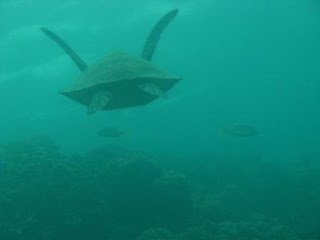The plight of the Kenyan Turtles: Update - Expo 103
Both the Hawksbill and Green Turtle are species that thrive in the coastal waters of East Kenya, being resident and nesting species. Despite the efforts of KWS, KESCOM and other NGOs and CBOs in the management of marine parks and reserves and promotion of community education programmes, turtles on the Kenyan coast are ever threatened by anthropogenic influences. Locally the Kisite-Mpunguti Marine Protected Area aims to maintain marine biodiversity and trying to establish a sustainable equilibrium between ever growing commercialisation and the natural environment. It is often extremely challenging.
In the past few months, we have seen increasing sightings of sea turtles during our snorkel surveys (see previous blogs) and this has given us hope that the management plans and conservation efforts are working.
However, during GVI’s marine research of the areas surrounding Wasini Island and Shimoni a couple of weeks ago, a shuddering realisation of man’s impact on the environment was seen by the marine team first hand. To the disgrace of the marine crew, a fully matured male Green Turtle, which we had previously thought to be surfacing, was trapped, dead, in a fishing net. Only recently entangled it had drowned, we attempted to photo ID and measure the at least 70 year old creature. Realising that if its tail had been where its head was, or if we had found it earlier, it may still be alive, didn’t start the week off positively.
-- A dead Green Turtle is found during our marine survey --
Since this horrifying sighting, our hope at the prospects for conserving the sea turtles has been reaffirmed in visiting local community run turtle groups. In association with KESCOM, we have visited groups in Vipingo and Msambweni; the enthusiasm and passion of the voluntary members for saving turtle species is hugely inspiring! They take responsibility for patrolling the beaches for poachers, monitoring turtle nests, tagging turtles and cleaning up the beaches. Vipingo alone has had 130 successful turtle nests hatching since January. This week, we will be visiting the Msambweni group again to give presentations and practical training - keep a look out for the next blog!
-- The plight of the graceful sea turtle --
In providing continued support, training and man-power to these groups in the coming months, we hope to change the fate of these fantastically graceful and peaceful creatures.
![]()












0 comments:
Post a Comment